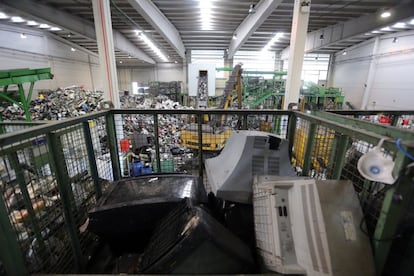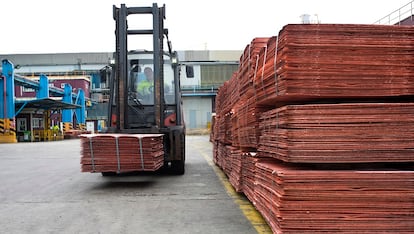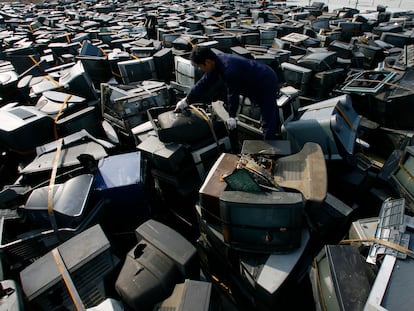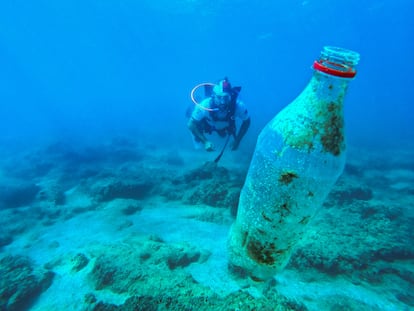A gold mine in the trash: how precious metals are recovered from discarded devices
An international mining company is constructing the only plant in southern Europe, and the seventh in the world, to recycle valuable metal elements present in electronic waste, amid criticism for polluting the environment
“A ton of discarded mobile phones is richer in gold than a ton of ore,” says Ruediger Kuehr, a professor at the University of Limerick (Ireland) and head of the United Nations Sustainable Cycles Programme (Scycle) in Germany. According to his calculations, “in a million cell phones, there are 24 kilograms (53.71 pounds) of gold, 16,000 of copper, 350 of silver and 14 of palladium.” Waste electrical and electronic equipment (or WEEE) is a kind of urban mine that is not currently being used to the full: only 20% of the world’s electronic waste is recovered.
Demand for electronics is outstripping the naturally available resources to make them, so in Huelva (Spain), the international mining company Atlantic Copper is building only the seventh large scale plant in the world (the fourth in the EU and the first in southern Europe) to extract these valuable materials from electronic waste. The investment that has been committed is €310 million ($337 million), which will create 350 jobs and implement state-of-the-art technology.
In the next 25 years, the demand for metals and minerals will multiply by 12. “Every year we need to process a Mount Everest,” says researcher Pablo Gámez Cersosimo, a Costa Rican living in the Netherlands. There he is the head of Naturally Digital, an organization specializing in sustainability, human behavior, ethics and digital well-being.
Extracting materials such as gold, silver, platinum, palladium, nickel, tin, antimony, or bismuth from the Earth is expensive and harmful to the environment. Moreover, these materials can be found in garbage, and according to Kuehr, “these resources could be recovered and returned to the production cycle. If we do not recycle these materials, we need to extract new supplies, which harms the environment.”
This so-called mine, which is now largely found in landfills, is made up of the more than 60 million tons of electrical and electronic waste that the world generates each year. Its combined weight is heavier than the Great Wall of China, the heaviest manmade object in the world. According to the Global E-waste Monitor, in just seven years and according to growth forecasts (between 3% and 4% per year), 74 million tons per year will be thrown away due to increased consumption, the shortened useful lifespan of devices, and limitations involved in repairing them.
However, anything with a cord, plug, or battery can be recycled. “In addition, recovering gold and other materials from waste saves a lot of CO2 emissions compared to mining virgin metals,” explains Kees Baldé of the United Nations University.
The presence of gold and silver in trash is the most striking. But even more significant is the concentration of copper (up to 16 tons per million cell phones, not counting other devices). Due to its conductivity and thermal capacity, this basic metal is three times more present in electric vehicles than in combustion vehicles and is essential for renewable energies, electrification, and digitization.

Demand for copper has increased by 50% in the last 20 years. However, large capacity waste copper recovery facilities are rare. The plants are located only in Belgium, Sweden, Germany, Canada, Japan and South Korea.
Spain, where the recovery of waste from electrical and electronic equipment exceeds the world average by 30 points and has reached 50% (above the European average, which is estimated at 48.5%), has been slow to join this exclusive club of massive recyclers. It will do so with a plant that is already being built in Huelva, with the capacity to process 60,000 tons a year, the equivalent of all the usable electronic and electrical waste generated by the country. In the first quarter of 2025, it is expected to make the first products entirely generated from waste.
Javier Targhetta, CEO of Atlantic Copper, the largest copper company in Spain (and a subsidiary of the North American group Freeport-McMoRan, the second-largest producer in the world), argues that “the plant is not only good business but also a great necessity for society.” “With our project [called CirCular], Spain will attain 100% processing and recycling. It is a very important step because it may be the first country in the world to achieve it.”
A ton of discarded mobile phones is richer in gold than a ton of oreRuediger Kuehr, professor at the University of Limerick (Ireland) and head of the United Nations Scycle office
The process begins with the waste managers, who separate the recyclable materials at source. To do this, some companies already have artificial intelligence capable of identifying and separating waste based on its origin and nature.

According to Targhetta, the company is interested in “everything that contains non-ferrous and precious metals, as well as circuit cards. They are the core of electrical devices and electronics,” he summarizes. That is the mine for non-ferrous metals (copper, tin, nickel) and precious metals (gold, silver, platinum, and palladium). The company plans to recover between 7,000 and 8,000 tons of copper per year; 1,000 tons of tin; about the same amount of nickel, and between 100,000 and 200,000 ounces of gold. “It’s a lot. We will become the leading producer of precious metals in Spain, by far,” the Atlantic Copper manager says.
If business is good and the need and demand already exist, why now and not before? And why are there so few plants in the world? “The technological process is complex because we are going to deal with a mixture of eight different materials,” clarifies Targhetta, who points out the company’s competitive advantage: the basic process is foundry, and the company already has a facility for that. Another reason is the high cost of investment: €310 million ($337 million), including the technology that they already have.
Technology to recycle metals
The raw material, prepared and provided by waste managers, becomes a more or less homogeneous mixture of particles, and then it is fed into a furnace that has been adapted by the mining company personnel in Huelva. The raw copper that comes out of the furnace is an intermediate product that already has around 94% of the desired element. The slag from that product includes tin, which can be separated very easily, and the other materials. The raw copper is incorporated into the existing processing line to make pure copper plates, weighing 350 kilograms.
The sludge resulting from the smelting process is filtered and dried, and exported, mostly to Japan and Korea, to complete the recycling process. But the company’s plans for the future involve being able to carry out this last treatment at its Huelva plant and complete 100% of the recycling process in Spain. The energy consumption of this recycling process is less than half that necessary for traditional mining extraction; and renewable sources, which already provide half of the current complex’s consumption, will be added to the energy generated by the new plant itself, which will account for 25%.
The project, which is already underway, has obtained environmental permits in record time, something that Targhetta attributes to the effort made by the company’s workers to complete the process, and explaining the project to the residents of Huelva, a city with just over 140,000 inhabitants.
Neighborhood opposition to “pollution”
The main dissenting voice about this project is the Mesa de la Ría, an organization that has had municipal representation in Huelva for the last 12 years, but which has lost its last two councilors in the May elections. This group, which has returned to being a social platform, maintains that the authorizations from the Port of Huelva and the City Council were approved without the basic public awareness and consultation measures. According to the Mesa de la Ría, chaired by Juan Manuel Buendía, recycling is carried out by “co-incineration or smelting of waste after crushing electronic devices, which requires the construction of new chimneys and cause an increase in pollution in Huelva.”
The organization states that the expected population living in the vicinity of the plant will exceed 8,000 and amenities will include a stadium for 18,000 people and educational centers, so it should be located further away. The group has reported the project to the Ombudsman and the regional government’s Health Department.
Pablo García Vila, the company’s environment coordinator, rejects the criticism: “We have not only taken into account the population located less than 1,000 meters from the project, as required by the guidelines established by the regional government’s Ministry of Health and Consumption, but also that of the entire environment and inhabited areas around the project.” Vila points out, in a company press release, “that during the public consultation process no allegations were presented to the study, as reflected in the Integrated Environmental Authorization.” In addition, Atlantic Copper sources stress that in the most advanced smelting processes, more efficient techniques are used in the furnaces and in the collection and cleaning systems for gases and particles, as well as the continuous monitoring of potential sources of pollution in order to avoid emissions.
Sign up for our weekly newsletter to get more English-language news coverage from EL PAÍS USA Edition
Tu suscripción se está usando en otro dispositivo
¿Quieres añadir otro usuario a tu suscripción?
Si continúas leyendo en este dispositivo, no se podrá leer en el otro.
FlechaTu suscripción se está usando en otro dispositivo y solo puedes acceder a EL PAÍS desde un dispositivo a la vez.
Si quieres compartir tu cuenta, cambia tu suscripción a la modalidad Premium, así podrás añadir otro usuario. Cada uno accederá con su propia cuenta de email, lo que os permitirá personalizar vuestra experiencia en EL PAÍS.
¿Tienes una suscripción de empresa? Accede aquí para contratar más cuentas.
En el caso de no saber quién está usando tu cuenta, te recomendamos cambiar tu contraseña aquí.
Si decides continuar compartiendo tu cuenta, este mensaje se mostrará en tu dispositivo y en el de la otra persona que está usando tu cuenta de forma indefinida, afectando a tu experiencia de lectura. Puedes consultar aquí los términos y condiciones de la suscripción digital.
More information
Últimas noticias
More than 40 Democratic lawmakers urge Trump in a letter to stop his ‘attempts to undermine democracy in Brazil’
The journal ‘Science’ criticizes Trump’s anti-renewable energy policy: ‘The US is failing to benefit from its own innovations’
Cubans hope for a miracle as dengue and chikungunya spread
The long shadow of the father figure in the films of Rob Reiner
Most viewed
- Christian Louboutin: ‘Young people don’t want to be like their parents. And if their parents wear sneakers, they’re going to look for something else’
- Cartels in Mexico take a leap forward with narco-drones: ‘It is criminal groups that are leading the innovation race’
- ‘El Limones’ and the growing union disguise of Mexican organized crime
- Liset Menéndez de la Prida, neuroscientist: ‘It’s not normal to constantly seek pleasure; it’s important to be bored, to be calm’
- The low-cost creative revolution: How technology is making art accessible to everyone











































